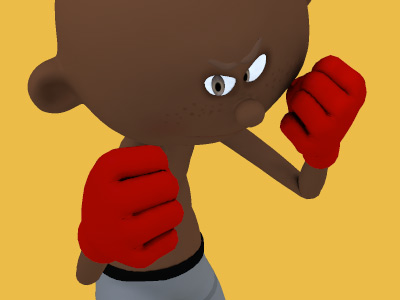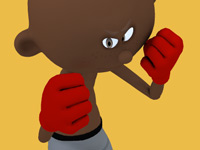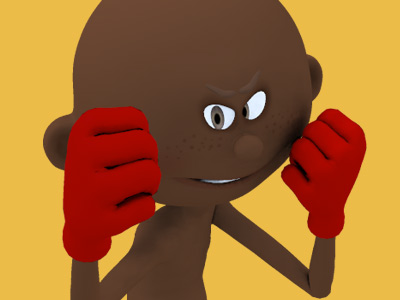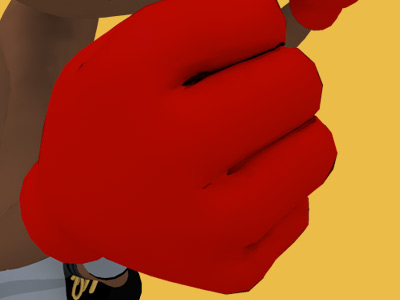Boxing

History of Boxing
Ancient history
The earliest known depiction of boxing comes from a Sumerian relief in Iraq from the 3rd millennium BCE Later depictions from the 2nd millennium BC are found in reliefs from the Mesopotamian nations of Assyria and Babylonia, and in Hittite art from Asia Minor. The earliest evidence for fist fighting with any kind of gloves can be found on Minoan Crete (c.1650–1400 BCE), and on Sardinia, if we consider the boxing statues of Prama mountains (c. 2000–1000 BC).
In Ancient Greece boxing was a well developed sport and enjoyed consistent popularity. In Olympic terms, it was first introduced in the 23rd Olympiad, 688 B.C. The boxers would wind leather thongs around their hands in order to protect them. There were no rounds and boxers fought until one of them acknowledged defeat or could not continue. Weight categories were not used, which meant heavyweights had a tendency to dominate. The style of boxing practiced typically featured an advanced left leg stance, with the left arm semi-extended as a guard, in addition to being used for striking, and with the right arm drawn back ready to strike. It was the head of the opponent which was primarily targeted, and there is little evidence to suggest that targeting the body was common.
Boxing was a popular spectator sport in Ancient Rome. In order for the fighters to protect themselves against their opponents they wrapped leather thongs around their fists. Eventually harder leather was used and the thong soon became a weapon. The Romans even introduced metal studs to the thongs to make the cestus which then led to a more sinister weapon called the myrmex ('limb piercer'). Fighting events were held at Roman Amphitheatres. The Roman form of boxing was often a fight until death to please the spectators who gathered at such events. However, especially in later times, purchased slaves and trained combat performers were valuable commodities, and their lives were not given up without due consideration. Often slaves were used against one another in a circle marked on the floor. This is where the term ring came from. In AD 393, during the Roman gladiator period, boxing was abolished due to excessive brutality. It was not until the late 16th century that boxing re-surfaced in London.
Early London prize ring rules
Records of Classical boxing activity disappeared after the fall of the Western Roman Empire when the wearing of weapons became common once again and interest in fighting with the fists waned. However, there are detailed records of various fist-fighting sports that were maintained in different cities and provinces of Italy between the 12th and 17th centuries. There was also a sport in ancient Rus called Kulachniy Boy or "Fist Fighting".
As the wearing of swords became less common, there was renewed interest in fencing with the fists. The sport would later resurface in England during the early 16th century in the form of bare-knuckle boxing sometimes referred to as prizefighting. The first documented account of a bare-knuckle fight in England appeared in 1681 in the London Protestant Mercury, and the first English bare-knuckle champion was James Figg in 1719. This is also the time when the word "boxing" first came to be used. It should be noted, that this earliest form of modern boxing was very different. Contests in Mr. Figg's time, in addition to fist fighting, also contained fencing and cudgeling. On 6 January 1681, the first recorded boxing match took place in Britain when Christopher Monck, 2nd Duke of Albemarle (and later Lieutenant Governor of Jamaica) engineered a bout between his butler and his butcher with the latter winning the prize.
Early fighting had no written rules. There were no weight divisions or round limits, and no referee. In general, it was extremely chaotic. An early article on boxing was published in Nottingham, 1713, by Sir Thomas Parkyns, a successful Wrestler from Bunny, Nottinghamshire, who had practised the techniques he described. The article, a single page in his manual of wrestling and fencing, Progymnasmata: The inn-play, or Cornish-hugg wrestler, described a system of headbutting, punching, eye-gouging, chokes, and hard throws, not recognized in boxing today.
The first boxing rules, called the Broughton's rules, were introduced by champion Jack Broughton in 1743 to protect fighters in the ring where deaths sometimes occurred. Under these rules, if a man went down and could not continue after a count of 30 seconds, the fight was over. Hitting a downed fighter and grasping below the waist were prohibited. Broughton encouraged the use of 'mufflers', a form of padded bandage or mitten, to be used in 'jousting' or sparring sessions in training, and in exhibition matches.
These rules did allow the fighters an advantage not enjoyed by today's boxers; they permitted the fighter to drop to one knee to end the round and begin the 30-second count at any time. Thus a fighter realizing he was in trouble had an opportunity to recover. However, this was considered "unmanly" and was frequently disallowed by additional rules negotiated by the Seconds of the Boxers. In modern boxing, there is a three-minute limit to rounds (unlike the downed fighter ends the round rule). Intentionally going down in modern boxing will cause the recovering fighter to lose points in the scoring system. Furthermore, as the contestants did not have heavy leather gloves and wristwraps to protect their hands, they used different punching technique to preserve their hands, because the head was a common target to hit full out. Almost all period manuals have powerful straight punches with the whole body behind them to the face (including forehead) as the basic blows.
The London Prize Ring Rules introduced measures that remain in effect for professional boxing to this day, such as outlawing butting, gouging, scratching, kicking, hitting a man while down, holding the ropes, and using resin, stones or hard objects in the hands, and biting.
Marquess of Queensberry rules (1867)
In 1867, the Marquess of Queensberry rules were drafted by John Chambers for amateur championships held at Lillie Bridge in London for Lightweights, Middleweights and Heavyweights. The rules were published under the patronage of the Marquess of Queensberry, whose name has always been associated with them.
There were twelve rules in all, and they specified that fights should be "a fair stand-up boxing match" in a 24-foot-square or similar ring. Rounds were three minutes with one-minute rest intervals between rounds. Each fighter was given a ten-second count if he was knocked down, and wrestling was banned. The introduction of gloves of "fair-size" also changed the nature of the bouts. An average pair of boxing gloves resembles a bloated pair of mittens and are laced up around the wrists. The gloves can be used to block an opponent's blows. As a result of their introduction, bouts became longer and more strategic with greater importance attached to defensive maneuvers such as slipping, bobbing, countering and angling. Because less defensive emphasis was placed on the use of the forearms and more on the gloves, the classical forearms outwards, torso leaning back stance of the bare knuckle boxer was modified to a more modern stance in which the torso is tilted forward and the hands are held closer to the face.
Late 19th and early 20th centuries
Through the late nineteenth century, the martial art of boxing or prizefighting was primarily a sport of dubious legitimacy. Outlawed in England and much of the United States, prizefights were often held at gambling venues and broken up by police. Brawling and wrestling tactics continued, and riots at prizefights were common occurrences. Still, throughout this period, there arose some notable bare knuckle champions who developed fairly sophisticated fighting tactics.
The English case of R v. Coney in 1882 found that a bare-knuckle fight was an assault occasioning actual bodily harm, despite the consent of the participants. This marked the end of widespread public bare-knuckle contests in England.
The first world heavyweight champion under the Queensberry Rules was "Gentleman Jim" Corbett, who defeated John L. Sullivan in 1892 at the Pelican Athletic Club in New Orleans.
The first instance of film censorship in the United States occurred in 1897 when several states banned the showing of prize fighting films from the state of Nevada, where it was legal at the time.
Throughout the early twentieth century, boxers struggled to achieve legitimacy. They were aided by the influence of promoters like Tex Rickard and the popularity of great champions such as John L. Sullivan.
SPORTS

RESOURCES
This article uses material from the Wikipedia article "Boxing" which is released under the Creative Commons Attribution-Share-Alike License 3.0.
© Stories Preschool. All Rights Reserved.









